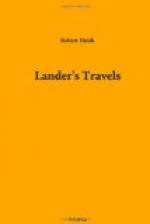The Portuguese in the meantime continued to extend their discoveries in another quarter, for in 1471, they reached the Gold Coast, when dazzled by the importance and splendour of the commodity, the commerce of which gave name to that region, they built the fort of Elmina or The Mine, making it the capital of their possessions on that part of the continent. Pushing onward to Benin, they received a curious account of an embassy said to be sent at the accession of every new prince, to a court of a sovereign named Ogane, who was said to reside seven or eight hundred miles in the interior. On the introduction of the ambassadors, a silk curtain concealed the person of his majesty from them, until the moment of their departure, when the royal foot was graciously put forth from under the veil, and reverence was done to it as a “holy thing.” From this statement it appears that the pope of Rome is not the only person, whose foot is treated as a “holy thing;” there is not, however, any information extant, that the Portuguese ambassadors kissed the great toe of the African prince, and therefore the superiority of the pope in this instance is at once decided. The statement, however, of the Portuguese ambassadors excited greatly the curiosity of the court on their return, and it was immediately surmised by them, that this mysterious potentate was more likely to be Prester John, than any person whom they had yet heard of. It must, however, be remarked, that it was a subject of great doubt and discussion to determine who this Ogane really was.
Although in possession of the extensive coast of Africa, the Portuguese had, as yet, no declared title to it, for that purpose, therefore, they appealed to religion or rather the superstition of the age. It was a maxim, which the bigots of the Vatican had endeavoured strongly to inculcate, that whatever country was conquered from infidel nations, became the property of the victors. This title was, however, not completed until it was confirmed by a special grant obtained from the pope, and accordingly the reigning monarch of Portugal, John II., obtained the grant of all the lands from Cape Bojador to the Indies inclusive. Robertson, speaking of this grant, says, “extravagant as this donation, comprehending such a large portion of the habitable globe, would now appear even in catholic countries, no person in the fifteenth century doubted but that the pope, in the plenitude of his apostolic power, had a right to confer it.”
The grant was no sooner confirmed by the pope, than John hesitated not a moment to style himself Lord of Guinea, giving his commanders, at the same time, instructions that, instead of the wooden crosses, which it had hitherto been the custom to erect in token of conquest, pillars of stone should be raised twice the stature of a man, with proper inscriptions, and the whole surmounted by a crucifix inlaid with lead. The first, who sailed from Elmina, for the purpose of planting these ensigns of dominion in regions yet




